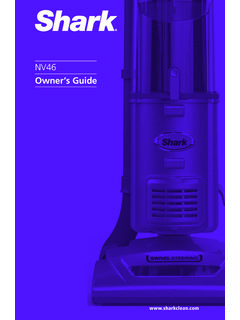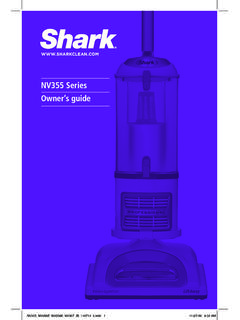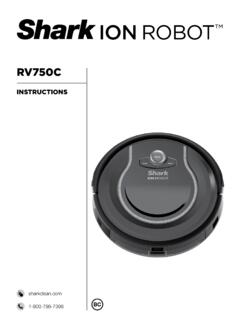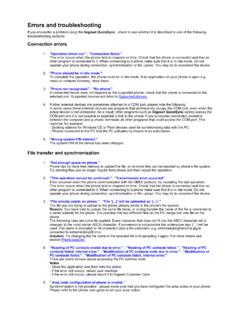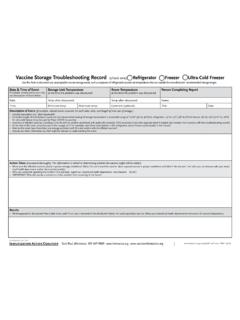Transcription of Robot Connectivity Troubleshooting Guide - …
1 Robot Connectivity Troubleshooting Guide 1 Incorrect Wi-Fi password Possible causes You may have entered the incorrect password for the network. Some routers are capable of operating at other frequencies. Sometimes networks on other frequencies will have the same SSID and password, and sometimes the passwords may be different. Possible resolutions Make sure you are using the correct password for your network. Verify that the password was entered properly, with no typos. 2 Dual-band routers Modern routers typically use two frequency bands, and 5 GHz. Shark robots can only connect to networks. They do NOT work with 5 GHz networks. How to find out if your router is dual-band: Look up the model on the manufacturer s website. Check the SSID name. If 2 networks are being broadcast from the router, it is most likely a dual-band router.
2 Be sure to select a network for all Shark robots. If there are duplicate SSIDs, confirm that the MAC address associated with the SSID corresponds to the Wi-Fi Access Point. The instructions for finding the MAC address will be in the Administration section of the Wi-Fi Access Point user manual. An issue known as band steering occurs when both the and 5 GHz networks have the same SSID. This can cause Connectivity issues when setting up connected devices. We recommended giving the networks separate names to prevent band steering problems. 3 My Robot repeatedly drops its Wi-Fi connection If your Robot frequently loses its W-Fi connection, it may mean that the Wi-Fi signal is not strong enough in the area where the Robot drops its connection. Router placement Router placement makes a big impact on Robot Connectivity . Try placing the router centrally, so coverage is uniform throughout the house.
3 Areas of bad coverage, or dead zones Even with centrally placed routers, there could be some dead zones around large metal objects, like refrigerators or stoves. You can often identify those by using your smart phone to search for available networks in areas where the Robot disconnects. Check the signal strength of available networks in those areas compared to other areas in your house. If you find a dead zone, try moving the router. Sometimes even a small movement of the router can improve or remove the dead zone. 4 My Robot can t connect to the Internet Firewall and ports: Firewall settings may block certain ports. Check your home connection technology such as router settings. The following ports should be open or whitelisted: 80 (http) and 443 (https) 53, 55055 and 55056 Please check the user manual for your router to verify the instructions on configuring firewalls.
4 MAC filtering: MAC filtering can block some devices from accessing your Wi-Fi network, and could keep your Robot from connecting. If your network is set up to only allow certain devices to connect, make sure you add the Robot s MAC address to the list. This can be typically found on the back of the Robot . 5 My Robot s Wi-Fi i con lights up, but my app says Not Connected When the Wi-Fi icon on the Robot illuminates, that means it is connected to your Wi-Fi network. The app may say that it is offline for several reasons, which are related to the router. 1. Using your smart phone or tablet, connect to the Wi-Fi router and make sure you have a strong internet connection. 2. Turn the Robot s power switch off and on. If this doesn t resolve the problem , go to step 3. 3. Try closing out the app and restarting it. If this doesn t resolve the problem , go to step 4.
5 4. Reset the router. This step often helps to reset all connections and allows for all devices to rejoin. NOTE: Factory reset instructions are available in the device manufacturer user manual. 6 How do I connect to a hidden network? Shark robots support GHz networks. To connect your Robot to a hidden network, you will need to type the name (SSID) of the hidden network instead of choosing it from the list displayed in the SharkClean mobile app during the onboarding process. Make sure to enter the correct SSID & password (both case-sensitive) to access your router/home network. 7 Check for interference: Many consumer devices use a GHz frequency, and they can interfere with the Wi-Fi signal from your Robot . Turn off those devices if you encounter connection issues. Here are some products that may use this frequency: Baby monitors Remote control toys Wireless video and audio equipment Microwave ovens Wireless keyboard and computer mice A neighbor s Wi-Fi Access Point can also be a source of interference.
6 A Wi-Fi analyzer app can identify interference. If Wi-Fi interference is identified, change the Wi-Fi channel. NOTE: To change the channel of a Wi-Fi Access Point, please refer to the Wi-Fi Access Point user manual. 8 Troubleshoot the initial device setup A number of things can go wrong when you initially set up your Robot . Follow these steps to troubleshoot the setup. To avoid unforeseen environmental issues, set up the Robot dock within 10 feet of the Wi-Fi Access Point, and in the same room, if possible. Do not place the Robot or dock less than one foot away from the Wi-Fi Access Point. Doing so may result in oversaturation of the Wi-Fi receivers. Once this initial setup is successfully completed, you can move the Robot dock to a different location. Once the dock is installed at its final location, make sure that the Robot can connect to the Wi-Fi Access point from there.
7 9 Pre-check the installation location and signal quality A weak Wi-Fi signal can be a problem . Pre-check the Wi-Fi signal level and quality at the location you plan to install the Robot and dock to help reduce wireless Connectivity issues: 1. Turn on the smart phone or tablet Wi-Fi that is connected to the correct SSID, and place it where the dock will be installed. 2. Check that the Wi-Fi signal and the data rate are acceptable for browsing. The Wi-Fi signal strength reported by your smart phone or tablet may not be identical to the strength experienced by the Robot , but should serve as a reasonable baseline for this location. NOTE: A Wi-Fi analyzing app can be used to check the signal level. There are many of these apps available on Android and in the iOS App Store. A bandwidth or speed-test app can be used to give a more accurate measurement of your internet connection quality.
8 The performance of the speed test depends on your Internet service plan. 10 What should I do if my Shark Robot won't connect to Wi-Fi, or loses Wi-Fi Connectivity ? Make sure your smart phone is connected to your home Wi-Fi network before trying to connect your Robot . Typical home Wi-Fi networks support both and 5 GHz. Make sure you are connected to a GHz network when you enter your SSID and password. Ensure your Robot is turned on and you hear an audio prompt. Do not use a VPN or a proxy server. Make sure Wi-Fi isolation is turned off on the router. There may be instances where your Shark Robot may lose Connectivity while operating, due to weak Wi-Fi signal, or from entering a Wi-Fi dead zone. o It is normal for your Robot to temporarily lose Connectivity when it goes under couches or moves through parts of your house that are far from your router, but your Robot should automatically reconnect to Wi-Fi.
9 If the Robot does not reconnect on its own, remove it from the dock. Press the power button on the side of the Robot to the OFF position for 10 seconds, then press it again to turn power back on, and place the Robot back on the dock. 11 What should I do if my Shark Robot can t connect to my Wi-Fi? Restart your phone. Reboot your Robot . o Make sure the power switch on the back of the DOCK is in the ON position. o Press the power button on the side of the Robot to the OFF position for 10 seconds, then press it again to turn power back ON. Reboot your router. o Unplug the router power cable for 30 seconds, then plug it back in. Allow several minutes for your router to reboot completely.


